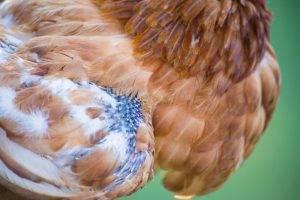With the coming of autumn, leaves aren’t the only things falling.
You may have noticed some of your flock members dropping feathers. Every year, the sight of suddenly nearly naked chickens causes panic for new chicken owners.
Birds, almost overnight, start looking like a strong wind came and left them stripped!
Although it seems alarming, chickens could naturally lose their feathers in autumn during their MOLT.
A molt is the shedding of old feathers, to make way for new ones. In the same way humans shed skin cells daily and reptiles and crustaceans shed their old skins, chickens molt out of their old feathers.
The feathers they have worn all year do not last forever. After several seasons of use, the feathers get dull and dingy. Old feathers are difficult to preen, and no longer “zip-up” like they once did. With winter fast approaching, our chickens need a fresh layer of feathers to stay warm, so they go through a molt.

The timing of a chicken’s molt always coincides with autumn. Research has determined a molt is triggered by decreased daylight. As the days grow shorter and the sun sinks to bed earlier each day, we are left with less hours of daylight.
The characteristics of a molting hen are first and foremost a major feather loss. Feathers start to fall out first around the top of the head, then move down the body, finishing with the tail. All hens molt differently. Some hide it well, but others may look almost naked. You will definitely notice a large number of feathers on the ground inside your coop. Along with feathers, there will also be a lot of dander and white looking dust. This “dust” comes from the new feathers that are growing out.
Along with looking pitiful, a molting chicken is not feeling it’s best. Growing new feathers places a strain on the nutrients inside the body. Since feathers are over 80% protein, chickens will be sending almost all their energy into regrowth. This means a hen will usually cease laying while molting. Supplemental protein can be given in moderation, but egg laying generally won’t resume until after all new feathers have grown in.
-This can take a while, as the average molt lasts 7-8 weeks!
There has been some research done that better layers molt out quicker, some as fast as 4 weeks. Other birds can take up to 12 weeks to fully complete the process.
In addition to looking nearly stripped of their feathers, a molting chicken also doesn’t feel as spry as usual. They may spend a lot of time resting in a corner, acting slightly lethargic. Keep and eye out for illness during this time. Since you can see their skin well, it is also a good time to check for lice.
The new feathers of a chicken start growing out as soon as the old feathers fall off. These new feathers are called pin feathers. They look almost like blue needles. The blue color comes from the blood inside the shaft. These feathers are very fragile and even painful if touched. Try not to handle your birds too much during this time as a broken pin feather can bleed and bleed! You may want to keep an eye out for any other chickens pecking on a molting hen. The sight of blood can cause aggressive pecking in chickens, so watch out for bullying.

Giving your flock some extra sources of protein- in moderation- can help them get through this tough time. Some feeds such, as wild game bird feed, have higher protein levels, and can be added to their diet. Some people give their flock canned tuna, cooked eggs, cod liver oil, and I have even heard handfuls of cat food work wonders. Adding protein should only be done during the molt, as too much protein year-round can actually be quite harmful.
The autumn molt can be a tough time for a chicken. It is a normal part of nature, and you can help ease the process with added protein and a little TLC. Soon, your flock will all be sporting brand new, glossy plumage and back to their old selves!